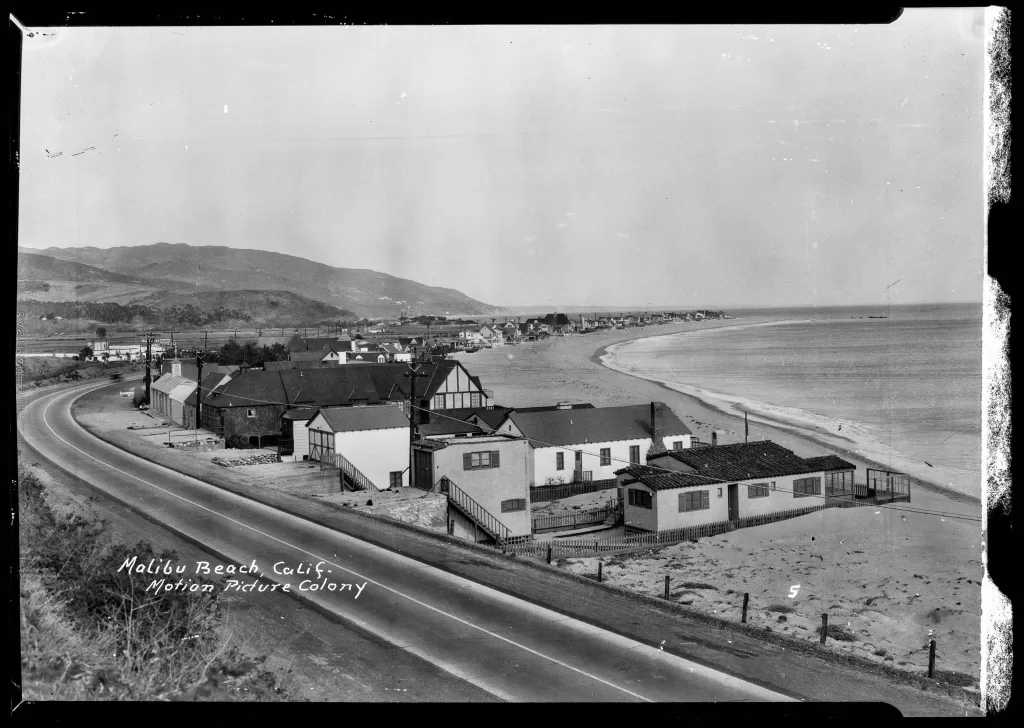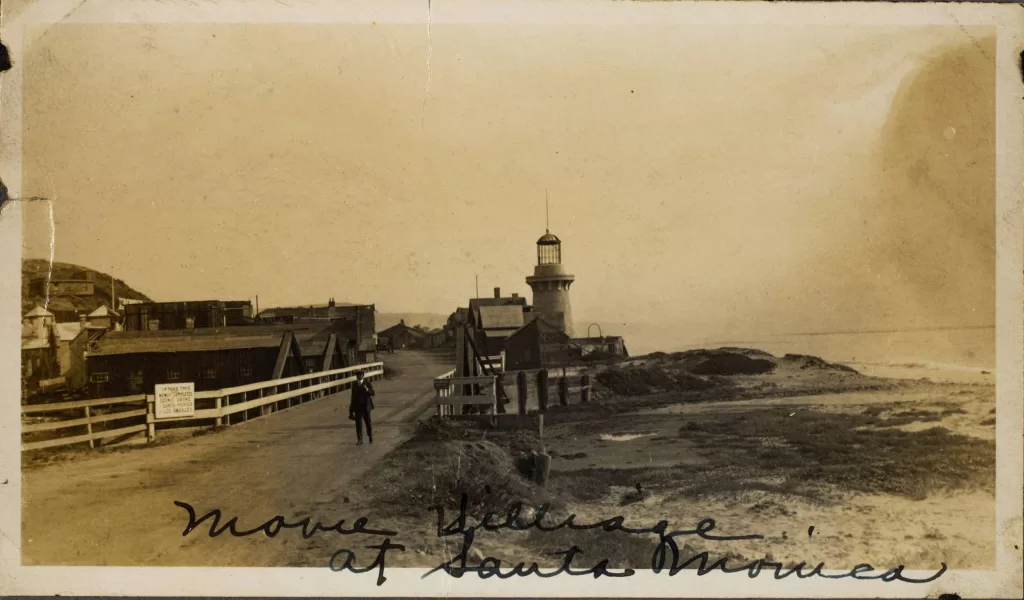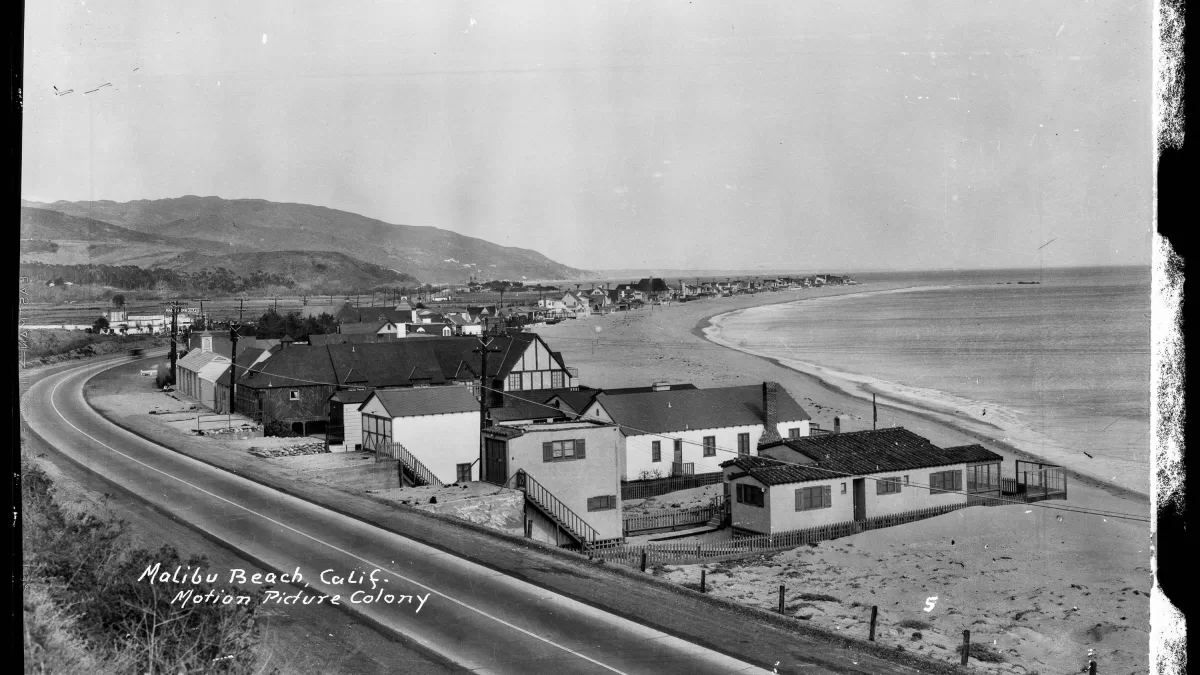PART TWO. In our last Lost Canyons LA column, we talked about the connection between the LA canyons and Hollywood’s golden age, both as a location for movies and as home to the actors who starred in them. In part two, we’re continuing the story westward to Topanga and the surrounding Santa Monica Mountains. From the early movie ranches to the celebrities who followed in their wake, there’s a lot of old Hollywood in these hills! Find Part One here.

The Santa Monica Mountains were an early favorite site for Hollywood, given the diverse and versatile terrain, hospitable weather, and seemingly endless space. From its inception, Hollywood had a need for a lot of room to mount the grand scale exterior scenes their popular westerns and action films required.
The idea of a dedicated movie ranch, that would allow studios the ease of filming on their own properties, began in 1911 when film pioneer Thomas Ince from the New York Motion Picture Company, had the vision to lease 18,000 acres of land for a studio in Santa Ynez Canyon that would eventually be dubbed “Inceville.”
This first movie ranch set the stage (literally) for a new kind of studio and, by 1916, it had even been recognized by the United States Government as a town, since it had its own post office. Inceville had five stages, two hundred dressing rooms, a saddlery and stables, an arsenal with thousands of firearms, and wardrobe buildings containing costumes ranging from cowboy to colonial settler to playboy prince. Permanent sets included Dutch, Irish and Japanese villages along with Wild West log cabins, East Indian streets, and a Sioux camp. Ince also had the genius idea to hire his own Wild West show from Oklahoma and bring its hundreds of cowboys, horses, and cattle, as well as an entire Lakota Sioux tribe, to live on the ranch and perform as in-house extras. Ince himself lived with his actress wife Elinor Kershaw and their children in a house overlooking his vast studio.

Among the first films produced at Inceville were the silent Western War on the Plains in 1912, civil war drama, The Battle of Gettysburg in 1913 and the big budget extravaganza Civilization in 1916. Ince eventually set his sights on forming a new studio, the Ince/Triangle Studios, in Culver City and sold Inceville, which continued to function as a movie ranch until it was destroyed in a 1922 fire.
Of course, the Pacific Palisades and its surrounding canyons weren’t just home to Inceville; by the 1920s movie stars had discovered this beautiful enclave not too far from the hustle and bustle of Hollywood.
Among the first to arrive was film director Hugo Ballin and his silent film actress wife Mable Croft Ballin who was best known for her roles in Jane Eyre in 1921 and 1923’s Vanity Fair, where she played the role of Becky Sharp.
Another early arrival was Will Rogers, famed vaudeville performer turned movie star who bought 22,000 acres of land between Temescal and Rustic canyons in 1924. At first just a weekend retreat where he, his wife Betty and their four children could ride horses, the arrival of a new road into the city, and the purchase of another adjoining 84 acres, meant that by 1926 Rogers could build his dream ranch house. According to a letter Rogers sent a friend, his property was “not really a ranch, but we call it that. It sounds big and don’t really do any harm.”
Along with their new house, the Rogers ranch also included a U-shaped barn and, remarkably (considering the steepness of the site), a polo field that required 150 mules to level. But Rogers wasn’t finished yet, by 1928 he owned twelve separate lots, including nearly half a mile of Pacific beachfront property.
After Rogers’ tragic death in an airplane crash off the coast of Alaska in 1935, his wife Betty continued to live at their Pacific Palisades home until her death in 1944. Betty Rogers left the ranch to the State of California with the condition that it be preserved and that polo matches continue to be held every year. Today, the Rogers’ property is, of course, known as the Will Rogers State Historical Park.
Another actor who lived in the area and who is today recognized with his own state park is Leo Carrillo who, although he acted in over 90 films, is best known for the role of Pancho in the 1950s TV show The Cisco Kid. Carrillo, who was the son of Santa Monica’s first mayor, bought a 14-acre property in Santa Monica Canyon in the 1930s where he built a small ranch. A lifelong conservationist, Carrillo served on the California Beach and Parks Commission for 18 years and played a key role in the state’s acquisition of Hearst Castle at San Simeon, the Los Angeles Arboretum, and the Anza-Borrego Desert State Park.
Following his death in 1961, the State of California named a Malibu beach and park in his honor. Leo Carrillo State Park has itself been used as a location for numerous movies, including Roger Corman’s Attack of the Crab Monsters in 1957 and the Sandra Dee classic Gidget in 1959.
Not to be outdone by the incredible success of Inceville, motion picture impresario Jesse L. Lasky (who would go on to found Paramount Pictures) teamed up with Samuel Goldwyn and Cecil B. DeMille to form the Jesse L. Lasky Feature Play Company in 1913 and build their own movie ranch in what is now the Upper Las Virgenes Canyon Open Space Preserve. Named Lasky Mesa, the 4,000-acre ranch was first used by director Cecil B. DeMille for his 1914 film Rose of the Rancho and contained “the largest scene ever set up” according to Moving Picture World Magazine at the time.
Other films that shot scenes at the ranch while Lasky was still in charge include D W Griffith’s Hearts of the World in 1918 and The Thundering Herd in 1925. Lasky Mesa was sold in the late 1930s to a wealthy rancher who continued to lease it out to film productions until the late 1950s. Films with scenes shot at the ranch during those years include 1939’s Gone with the Wind (the famous sunrise scene where Vivien Leigh’s Scarlett vows to never go hungry again), The Charge of the Light Brigade in 1936 and They Died With Their Boots On in 1941.
The area that is now Malibu Creek State Park was another favorite filming spot for early Hollywood and would later become a studio ranch. Among the first films to be produced in this area was 1919’s Daddy Long Legs starring Mary Pickford, which filmed a scene at the Malibu Creek Rock Pool. Other films to utilize the pool, then belonging to the wealthy Crags Country Club, were Buster Keaton’s The Paleface in 1921 and Annie Laurie starring Lillian Gish in 1927.
20th Century Fox eventually acquired the property, which became “Century Ranch” in 1946, after the studio had used the area for filming the critically acclaimed 1941 film How Green Was My Valley, and realized the potential in owning it as a permanent site.
Century Ranch was used for movies such as the 1948 Cary Grant and Myrna Loy vehicle Mr. Blandings Builds His Dreamhouse, Anthony Quinn and Marlon Brando’s Viva Zapata in 1952 and 1956 musical Western Love Me Tender, starring Elvis Presley. The ranch also stood in for Hong Kong in the famous hilltop meeting place between William Holden and Jennifer Jones in Love is a Many Splendored Thing, filmed in 1955. Later classics filmed on the ranch include Planet of the Apes in 1968 starring Charlton Heston and Roddy McDowell and the exteriors scenes for the TV series M*A*S*H.
Paramount Pictures bought a large piece of property to create its own movie ranch nearby, where they built temporary and permanent sets that could be used in multiple productions. The Western town set remained in use until it was destroyed in the Woolsey Fire in 2018. Movies like Bob Hope’s Caught in the Draft in 1941, The Song of Bernadette in 1943, and countless TV Westerns, would all utilize Paramount Ranch.
Nearby Topanga Canyon has also played host to several films from Hollywood’s golden era and was also a favorite weekend retreat for the silent film stars of the time. Two early movies filmed in the canyon include As the Sun Went Down in 1919 and Marion Davies’ 1921 hit Buried Treasure, where Topanga passed for a secluded Spanish island.
One of the most beloved actors who called Topanga home was Will Geer, who opened his still operating Theatricum Botanicum in 1951 after being blacklisted by Hollywood during the McCarthy era.
Topanga’s famous Moonfire Ranch, owned by S&H Green Stamps fortune heir and animal rights activist Lewis Beach Marvin III, was also the setting for the 1966 film Harper starring Paul Newman and Lauren Bacall.
With the Santa Monica Mountain movie scene firmly established by the late 1920s, there was a growing desire among Hollywood elites to have weekend homes or even a permanent address close by. In 1892, Frederick Hastings Rindge and his wife May Knight Rindge acquired a large parcel of land that included more than 20 miles of unspoiled coastline called Rancho Topanga Malibu Sequit. Frederick Rindge died in 1905.
As the 1920s drew to a close, May Rindge had fallen on hard times after losing a court battle that led to the construction of what is now Pacific Coast Highway through her property. Needing to raise money, Rindge decided to lease one mile of her coastline to investors looking to build new homes. Dubbed the Malibu Movie Colony, local studios reportedly loaned out set designers to build the small beachside homes that attracted celebrities like Dolores Del Rio, Clara Bow, Barbara Stanwyck and Gloria Swanson. By the mid-1930s, residents were given the chance to purchase their homes and the development continued to grow rapidly, adding more names like Bing Crosby, Gary Cooper, Merle Oberon, Clark Gable, and Carole Lombard to the list of residents. Frank Capra, the director of all-time classics It’s a Wonderful Life and Mr. Smith Goes to Washington was one of the Colony’s first board of directors.
Over the years, Malibu and the Santa Monica Mountains have remained among the most star-studded and often filmed areas in Greater Los Angeles. Many of the locations mentioned here are located in public open space that is part of the Santa Monica Mountains National Recreation Area, including the location of the M*A*S*H film site and Rock Pool at Malibu Creek State Park, the former Western Town site at Paramount Ranch, and Lasky Mesa in Upper Los Virgenes Canyon Open Space Preserve.
Malibu Creek State Park has a fantastic history section on its website that maps the locations of nearly all the films mentioned here. http://www.malibucreekstatepark.org/history.html













